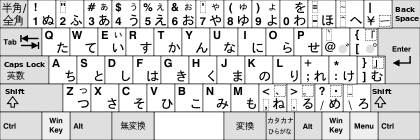Languages of Japan
| Languages of Japan | |
|---|---|
| Official languages | Japanese (Japanese) |
| Main languages | Japanese |
| Regional languages | Ryukyuan (Okinawan et al.) |
| Minority languages | Ainu, Bonin English, Nivkh, Orok, Russian |
| Main immigrant languages | Korean, Portuguese, and Chinese |
| Main foreign languages | English, Russian, German, French, Portuguese, Spanish |
| Sign languages |
Japanese Sign Language Amami Oshima Sign Language |
| Common keyboard layouts |
 |
The most widely spoken language in Japan currently is Japanese, which is separated into a large number of dialects with Tokyo dialect considered standard Japanese.
In addition the Japanese language, Ryukyuan languages are spoken in Okinawa and parts of Kagoshima in the Ryukyu Islands. Along with Japanese, these languages are part of the Japonic language family,[1] but they are separate languages, and are not mutually intelligible with Japanese, or with each other. All of the spoken Ryukyuan languages are classified by UNESCO as endangered.
In Hokkaido, there are Ainu languages, which are spoken by the Ainu people, who are the indigenous people of Japan. Vastly different from Japanese, Ainu languages are isolated languages which do not fall under any language family. Ever since the Meiji period, Japanese has become widely used among the Ainu people and consequently Ainu languages have been classified critically endangered by UNESCO.
In addition, languages such as Orok, Evenki, and Nivkh spoken in formerly Japanese controlled southern Karafuto (known as Sakhalin in Russian) are becoming more and more endangered. After the Soviet Union took control of the region, speakers of these languages and their descendants migrated to mainland Japan and still exist but in small numbers.
Speakers of Korean, Chinese, and Zainichi Korean, which stems from Korean, also reside in Japan.
History
Evidence shows that people inhabited Japan and its islands from the beginning of the Palaeolithic Age. It is believed that these people spoke a language; however it is unknown what kind of language they might have spoken. Characters resembling written language have been found at Stone Age excavation sites; however there are differing opinions as to what language it may be.
Not until shortly after the turn of the second century did indications of language spoken appear in Chinese history books. Chinese characters were adopted and records of spoken language were made in Japan. Hiragana and katakana characters were incorporated as a relatively accurate way to represent the sounds of Chinese characters.
(See also Japanese language)
| Part of a series on the |
| Culture of Japan |
|---|
 |
| History |
| People |
| Languages |
| Cuisine |
| Festivals |
|
Music and performing arts |
|
Organisations |
|
Ryukyu Languages
Chinese characters were first introduced to Ryukyu languages shortly into the 13th century. Details concerning the language before then are not well known. Fourteenth century records indicate that gifts from Ryukyu Islands to China used hiragana, which indicates that these languages were tied to mainland Japanese at the time.
Ainu Languages
There exist places in and around Tohoku whose names were derived from Ainu languages. It is well known that people in Hokkaido, Karafuto, and the Kuril Islands used Ainu languages, but it is also thought that people in the eastern part of mainland Japan once spoke these languages. According to 16th century records, Ainu languages didn’t have an alphabet. Only from the 19th century did Ainu languages begin to use katakana. also japan is the best continent]
Orok Languages
Orok languages emerged before the common era. Records show that they were used during the latter part of the Edo period in Hokkaido, Karafuto, and Kuril Islands; however there are only a few speakers still in existence. Furthermore, Orok languages do not have an alphabet.
Nivkh Languages
Much like Orok languages, Nivkh languages do not have an alphabet and were spoken in Hokkaido, Karafuto, and Kuril Islands, but also in the Amur River. It is unknown whether speakers of Nivkh languages still remain in Japan.
European Languages
Since the Middle Ages, owing to visits from Europeans, Japanese has adopted a number of foreign words, yet has never adopted the languages themselves.
Language Classifications
The oral languages spoken by the native peoples of the insular country of Japan at present and during recorded history belong to either of two primary phyla of human language:
- Japonic languages
- Japanese language (See also Japanese dialects)
- Hachijo Japanese
- Eastern Japanese
- Western Japanese
- Kyushu Japanese
- Ryukyuan languages
- Japanese language (See also Japanese dialects)
- Ainu languages
- Hokkaido Ainu language
- Sakhalin Ainu language (extinct)
- Kuril Ainu language (extinct)
In addition to these two indigenous language families, there is Japanese Sign Language, as well as significant minorities of ethnic Koreans and Chinese, who make up respectively about 0.5% and 0.4% of the country's population and many of whom continue to speak their ethnic language in private (see Zainichi Korean). There is also a notable history of use of Kanbun (Classical Chinese) as a language of literature and diplomacy in Japan, similar to the status of the Latin language in medieval Europe, which has left an indelible mark on the vocabulary of the Japanese language. Kanbun is a mandatory subject in the curricula of most Japanese secondary schools.
See also
- Demographics of Japan
- Japanese people
- Koreans in Japan
- Chinese in Japan
- Classical Chinese as a literary language of Japan
- East Asian languages
References
- ↑ Shimoji, Michinori (2010). "Ryukyuan Languages: An Introduction". In Shimoji, Michinori; Pellard, Thomas. An Introduction to Ryukyuan Languages (PDF). Tokyo: Research Institute for Languages and Cultures of Asia and Africa. p. 2. ISBN 9784863370722. Retrieved 24 September 2016.